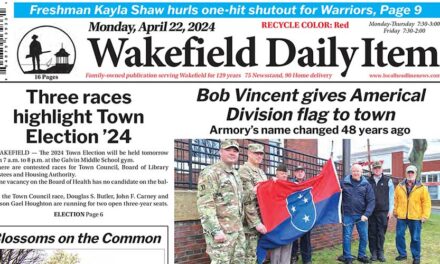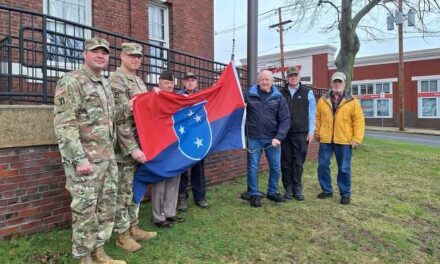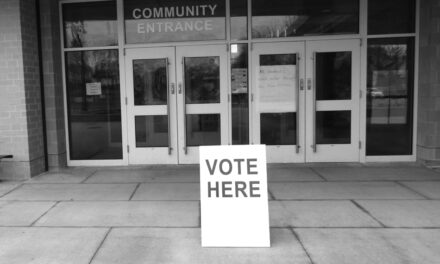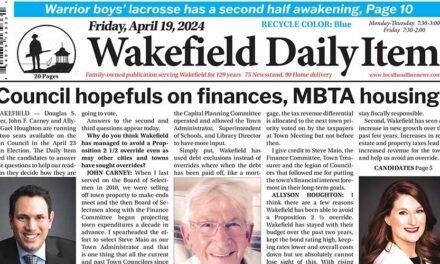Published in the March 21, 2017 edition.
By DAN TOMASELLO
LYNNFIELD — On March 16, the Planning Board voted 3-1 to designate the proposed two-story medical office building at MarketStreet Lynnfield as a minor modification to the Planned Village Development District (PVDD) agreement despite pleas from several residents.
National Development Managing Partner Ted Tye unveiled plans last month to build a three-story medical office building that would have Lahey Health as a tenant. In addition to medical offices, there would be an urgent care center in the building as well. The building would be located diagonally behind Davio’s Northern Italian Steakhouse and Lululemon Athletica.
After listening to concerns from MarketStreet abutters, Tye agreed to withdraw the original proposal and submitted plans for a two-story, 30-foot high building instead. Tye agreed to downsize the building even though Town Counsel Tom Mullen stated the original three-story building was “not prohibited” at MarketStreet if it was kept under a maximum allowable height of 45 feet.
Tye made the case the project was a minor modification and gave the planners a variety of different information if the board voted to designate the project as a major or minor change to the PVDD. He said the Planning Board allowed relocating buildings at MarketStreet in 2011, 2013 and 2014.
“The board considered those minor changes,” said Tye. “We are asking this to be considered as a minor change as well.”
Tye argued the PVDD stipulates a minor change allows building and parking adjustments as well as “other site details that do not affect the overall build-out of the site.” He also said the project is a minor modification because The Green open space area and the residential buildings, MarketStreet Apartments and Colonial Village, have already been built and neither would be impacted by the project. He noted the MarketStreet development is capped at 475,000 square feet, which “will not change” because of the project.
“Zoning allows a two-story, 45-foot building and this is a two-story, 30-foot building,” said Tye. “This makes sense as a minor change.”
Tye also stressed the PVDD allows a medical office building to be located at the site, and claimed the pact allows a small quantity hazardous waste generator in order to dispose hazardous waste.
Planning Board co-Chairman John Faria and fellow Planning Board members Heather Sievers and Michael Sheehan voted to designate the two-story building as a minor modification to the PVDD. Planning Board co-Chairman Alan Dresios voted no. Planner Charles Wills was not present at the meeting.
More concerns expressed
Faria allowed for public input at the meeting, and several residents aired concerns about the project once again.
Fernway resident David Basile argued the project should be designated as a major change, mainly because it will be a medical facility. He noted Wakefield Town Administrator Stephen P. Maio has aired concerns about sewage disposal and water usage at MarketStreet, their impact on Wakefield and the fact that any major modification to the MarketStreet plan is subject to an amended and restated sewer agreement between the two towns and the MWRA.
“I think for that reason alone that this be considered a major change,” said Basile.
Basile also said the medical building should be considered a major change because of the project’s impact on the Lynnfield Water District, traffic, parking and the building’s location.
“Let’s call this a major change,” said Basile. “Put it through as a major change and give the citizens their fair due.”
Faria said Basile made several valid points, but said many of his concerns were outside of the Planning Board’s purview.
While Police Chief David Breen said he thinks it would be beneficial to have a doctor’s office at MarketStreet, he expressed concerns about the urgent care facility. He is concerned people addicted to opioids will try to use the urgent care center in order to get prescriptions.
“That will lead to an increase in responsibility and drag on the Police Department,” said Breen.
Breen said there will be a high demand for urgent care facilities with Union Hospital closing, and said having one at MarketStreet will have a “major impact” on the Police Department and the Fire Department because ambulances will need to transport some patients to area hospitals. He said this will put a strain on both departments’ resources and will be costly to local taxpayers.
Bourque Road resident Mark McDonough agreed with Breen’s opinion.
“There is going to be a big demand on the Police and Fire departments,” said McDonough.
National Development Senior Vice President Doug Straus said the urgent care center “is not an emergency room.” He said it would be similar to facilities located in strip malls and pharmacies.
“No ambulances will bring people here,” said Straus. “The only time there will be an ambulance here is if someone needs to go to the hospital. It’s just an urgent care center for minor medical issues that can be addressed outside of the hospital or a doctor’s office.”
Wally McKenzie, 4 Debston Ln., repeated previous arguments that the proposed medical office building is a violation of the development agreement National Development has with the town. He said the building should be moved to a different location, preferably to an area that is further away from Walnut Street.
“I am asking you to turn this down,” said McKenzie. “I am asking you to honor the agreements made between National Development, the town and the neighbors.”
Planning Board weighs-in
Faria claimed repeatedly throughout the meeting the only difference between designating the medical building as a major or minor change was whether the planners would be required to publish a legal notice in a newspaper before a public hearing is held.
While Faria initially questioned the logic of “spending money on a public notice” when there were news reporters in the audience, he later changed his mind after Alexandra Road resident Joe DeMaina said publishing a legal notice is “a small amount of money.” Faria stipulated in the motion planners would take out a legal notice in a newspaper.
Additionally, Faria said the project should be designated as a minor change because the building “has been reduced from three stories to two stories.” He agreed with Tye’s opinion the project does not affect the 475,000 square foot build-out requirements.
Faria said residents will be allowed to weigh in on the project regardless of whether planners decided to designate the project as a major or minor change.
“(The public) will have full say,” said Faria. “I want the citizenry to have full throat on what is going on here.”
Dresios said he believed the project was a major change to the PVDD because of the new building’s location.
“I think it’s a major change and I think the fair thing to do for the public is to treat it as a major change,” said Dresios. “This is not a minor change to the building’s orientation or an adjustment to the (building) envelope. It doesn’t fit into that category, which knocks it down to a major change. It’s well within the bylaw.”
Dresios requested that an expert review the plans for the small hazardous waste generator in order to “find out what is prohibited and what isn’t” in the PVDD.
“I want someone to give us an opinion about that,” said Dresios.
Faria noted National Development could “potentially have a problem in the future if Lahey is deemed to be a facility generator of hazardous waste.”
“The Board of Health could shut them down,” said Faria. “It’s a Board of Health issue. It’s not germane to our discussion. The issue before us is the building itself and not its potential use.”




